Contents
| |||||
| Decades: | |||||
|---|---|---|---|---|---|
| See also: | |||||
Events in the year 2019 in Morocco .
| |||||
| Decades: | |||||
|---|---|---|---|---|---|
| See also: | |||||
Events in the year 2019 in Morocco .


Abū Yūsuf Yaʿqūb ibn Yūsuf ibn Abd al-Muʾmin al-Manṣūr, commonly known as Yaqub al-Mansur or Moulay Yacoub, was the third Almohad Caliph. Succeeding his father, al-Mansur reigned from 1184 to 1199. His reign was distinguished by the flourishing of trade, architecture, philosophy and the sciences, as well as by victorious military campaigns in which he was successful in repelling the tide of the Reconquista in the Iberian Peninsula.
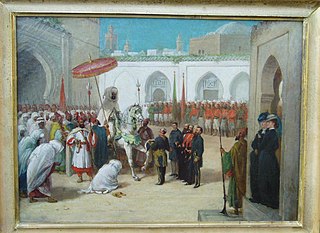
MawlayMuhammad bin Abd al-Rahman, known as Muhammad IV, born in Fes in 1803 and died in Marrakesh in 1873, was the Sultan of Morocco from 28 August 1859 to 16 September 1873 as a ruler of the 'Alawi dynasty. He was proclaimed sultan after the death of his father, Abd al-Rahman. His reign marked a series of reform to tackle European influence on Morocco, as Ottoman Algeria had just been conquered by France in 1830, leading to European nations entering military conflicts with Morocco, such as the Battle of Isly with France in 1844 and the Battle of Tetuan with Spain in 1860. He was succeeded by his son Hassan I.

El Badi Palace or Badi' Palace is a ruined palace located in Marrakesh, Morocco. It was commissioned by the sultan Ahmad al-Mansur of the Saadian dynasty a few months after his accession in 1578, with construction and embellishment continuing throughout most of his reign. The palace, decorated with materials imported from numerous countries ranging from Italy to Mali, was used for receptions and designed to showcase the Sultan's wealth and power. It was one part of a larger Saadian palace complex occupying the Kasbah district of Marrakesh.

Abdallah Ibrahim was a Moroccan politician and a figure of the national movement and was the left-wing Prime Minister of Morocco between December 16, 1958, and May 20, 1960. He was the third Prime Minister of Morocco and served under king Mohammed V. He also served as the foreign minister from 1958 to 1960.
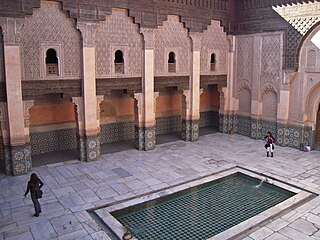
Abdallah al-Ghalib Billah was the second Saadian sultan of Morocco. He succeeded his father Mohammed al-Shaykh as Sultan of Morocco.
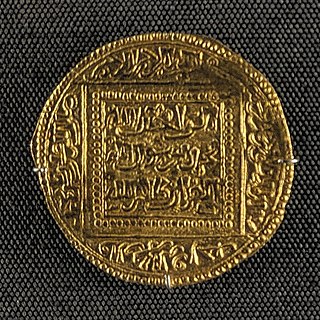
Abu Yahya Abu Bakr ibn Abd al-Haqq was a Marinid ruler.
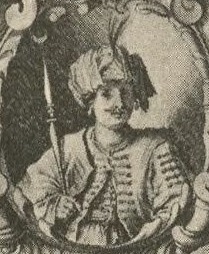
Mohammed esh Sheikh es Seghir was the sultan of Morocco from under the Saadi dynasty.
Abu Faris Abdallah, known as al-Wathiq Billah was a Saadi dynasty ruler of some areas of Morocco. He was one of the sons of Ahmad al-Mansur and one of his harem slave concubines named Elkheizourân. He ruled in the south of the country as well as Marrakesh and Fez between 1603 and 1608. He had numerous fights with his half-brother Zidan Abu Maali.
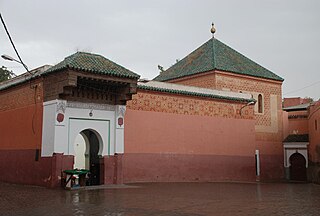
Abu Mohammed Abdallah al-Ghazwani was a Sufi saint from Morocco in the tradition of al-Jazuli and ash-Shadhili. He was the successor of Abdelaziz al-Tebaa. Some two hundred years after his death he became one of the Sabaatou rijales, the seven saints of Marrakesh. Abdallah al-Ghazwani wrote on the idea of the Tariqa Muhammadiyya. Al-Ghazwani was also renowned for his skill in sinking wells and constructing channels.
Muhibb al-Din Abu Abdallah Muhammad ibn Umar ibn Rushayd al-Fihri al-Sabti was a Moroccan judge, writer and scholar of Hadith, born in Sabta, Morocco. In 1284 he travelled east for three years to perform the hajj and study. During his travels he became friends with the future vizier of Granada Ibn al-Hakim al-Rundi. By Ibn al-Hakim's invitation, he came to Granada in 1292 or 1293 and was appointed as an imam and then a judge. After the vizier's assassination in 1309, he returned to Morocco where he became imam in Marrakesh, and then a close advisor to the Marinid Sultan Abu Sa'id Uthman II. He died in February 1321 in Fez. He was well respected both during his life and in historical accounts, and left his writings on various topic, including on hadith, literature, and an account of his travel (rihla).
Abdelaziz al-Tebbaa or Sidi Abdelaziz ibn Abdelhaq Tebbaa al-Hassani was the founder of the first sufi zawiyya of the Jazuli order in Marrakesh.

Abū al-Ḥakam ʿAbd al-Salām b. ʿAbd al Raḥmān b. Abī al-Rijāl Muḥammad b. ʿAbd al-Raḥmān al-Lakhmī al-Ifrīqī al-Ishbīlī was an Arab Sufi figure of Al-Andalus, considered to be one of the greatest Sufi masters and hadith scholars. He spread his teachings in the first half of the 12th century.
Abu Muhammad ar-Rashid Abd al-Wahid was an Almohad caliph who reigned from 1232 until his death.

Abū Ḥafṣ ‘Umar al-Murtaḍā was an Almohad caliph who reigned over part of present-day Morocco from 1248 until his death.
Abu Idris al-Wathiq, known as Abu Dabbus, was the last Almohad caliph who reigned in Marrakesh from 1266 until his death.

Chaima Doublal, known professionally as Chaimae Abdelaziz is a Moroccan Singer who rose to popularity as a contestant in the fourth season of The Voice Ahla Sawt, broadcast on MBC. She sang various songs of both Moroccan and Middle-Eastern repertoires and reached the quart-finals.
Events in the year 2020 in Morocco.
Abu Musa al-Jazuli, was a Moroccan philologist and grammarian, who produced an encyclopaedia called Al-Qānūn, or Al-Muqaddima of al-Jazūlī. Many scholars wrote tafsir or sharḥ (commentaries), and it was incorporated in many grammars. Nevertheless, its opacity challenged the best language scholars. Al-Jazūlī was the first to introduce Al-Ṣiḥāḥ fī al-lughah of al-Jawhari to the Maghreb, and he makes many references to this and other works in his Muqaddima.
al-Abbās ibn Ibrāhīm as-Samlālī al-Marrākshī was a Moroccan historian, faqih, and judge from Marrakesh. He is notable for his book Information About the Notables of Marrakesh and Aghmat.
Ahmad al-Abbas was the last Sultan of the Saadi dynasty of Morocco. He was proclaimed Sultan in Marrakesh in the year H.1064 after the death of his father, Mohammed esh-Sheikh es-Seghir. In 1659, he was assassinated by his maternal uncle, Abdul Karim Abu Bakr Al-Shabani. His uncle assumed power as Sultan in Marrakesh until 1667 when he was in turn murdered, it happened shortly before the Alaouite Sultan Moulay Al-Rashid of the current ruling Dynasty conquered the city in 1668.